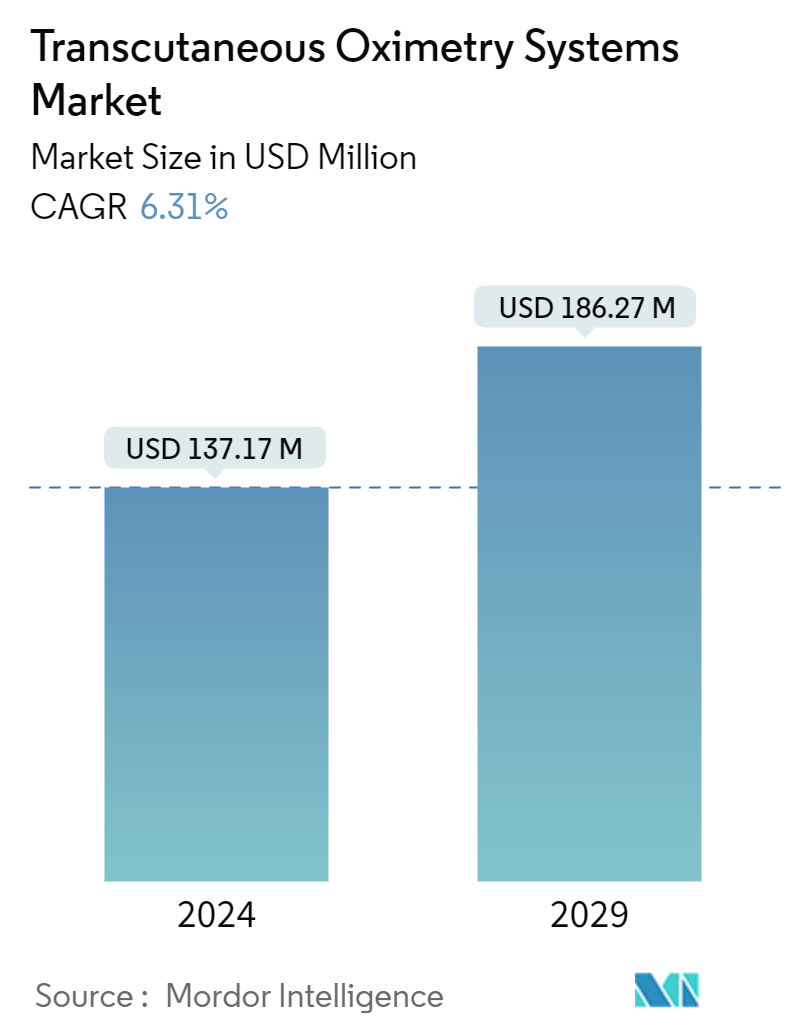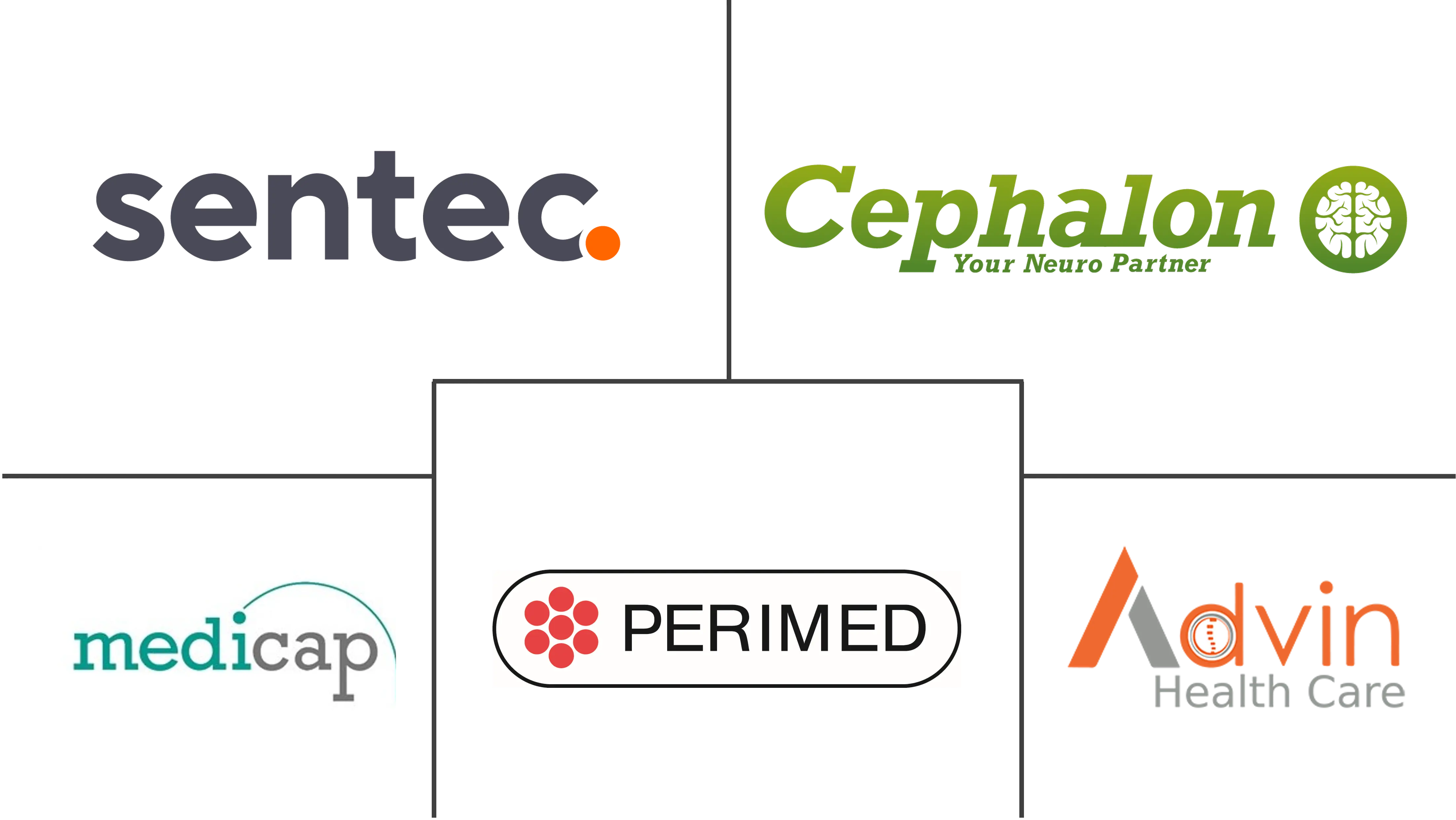| Study Period | 2019 - 2029 |
| Market Size (2024) | USD 137.17 Million |
| Market Size (2029) | USD 186.27 Million |
| CAGR (2024 - 2029) | 6.31 % |
| Fastest Growing Market | Asia Pacific |
| Largest Market | North America |
| Market Concentration | High |
Major Players*Disclaimer: Major Players sorted in no particular order |
Transcutaneous Oximetry Systems Market Analysis
The Transcutaneous Oximetry Systems Market size is estimated at USD 137.17 million in 2024, and is expected to reach USD 186.27 million by 2029, growing at a CAGR of 6.31% during the forecast period (2024-2029).
Several factors, such as the increasing prevalence of peripheral vascular disorder and wound healing disorder, growing adoption of advanced monitoring systems for blood flow monitoring, and increasing prevalence of diabetic foot ulcers, are expected to boost market growth during the forecast period.
The rising prevalence of peripheral vascular and wound healing disorders is set to propel the growth of the transcutaneous oximetry systems market. Frequent wound-healing disorders often stem from circulatory deficiency, malnutrition, metabolic disorders, sepsis, and inflammation.
For instance, according to the Global Hunger Index, as of May 2022, about 1.5 million children under the age of five, or 45% of Somalian children, were projected to face acute malnutrition through the end of the year, including 386,400 who were expected to be severely malnourished. Thus, an increase in malnutrition leads to slow wound healing, thereby decreasing the blood oxygen level at the injury site. In such instances, transcutaneous oximetry systems are widely used for measuring oxygen levels, thereby driving the market’s growth during the forecast period.
Moreover, the rise in the utilization of transcutaneous oximetry systems in peripheral vascular disorders to detect the systems is expected to fuel market growth. For instance, an article published in November 2022 in PubMed highlighted that transcutaneous oximetry effectively detects upper limb arterial compression and related symptoms when patients with suspected thoracic outlet syndrome (TOS) perform arm abduction. These findings are expected to drive the adoption of transcutaneous oximetry systems in healthcare facilities, thereby propelling market growth.
Transcutaneous oximetry systems are increasingly utilized to assess the necessity of amputation, particularly in cases of diabetic foot ulcers, a leading cause of such procedures. For instance, an article published by the National Centre for Biotechnology Information in August 2022 highlighted that diabetic foot ulcers rank prominently among the complications faced by individuals with diabetes mellitus. These ulcers often arise from factors such as poor glycaemic control, neuropathy, peripheral vascular disease, or neglect of foot care.
In addition to the above context, approximately 60% of individuals with diabetes experience neuropathy, often resulting in foot ulcers. Globally, diabetic foot ulcers have an annual incidence ranging from 9.1 to 26.1 million cases. About 15% to 25% of all diabetes patients are at risk of developing these ulcers at some point in their lives.
Furthermore, as per 2022 updated data published by the International Diabetes Federation, about 643 million people are expected to suffer from diabetes in 2030 globally, and this number is projected to reach 784 million by 2045. Thus, the expected increase in the diabetic population raises its risk of developing diabetic foot ulcers, fueling the need to monitor any damage or blockage in the blood vessels. This is anticipated to propel the growth of the transcutaneous oximetry market during the forecast period.
Thus, the rise in peripheral vascular disorders, diabetic mellitus, and the increase in the adoption of transcutaneous oximetry systems for detecting oxygen levels in various diseases are expected to drive market growth. However, the high cost of transcutaneous oximetry systems is expected to restrain market growth.
Transcutaneous Oximetry Systems Industry Segmentation
As per the scope of the report, transcutaneous oximetry systems are used for transcutaneous oximetry (TCPO2) tests. Transcutaneous oximetry systems are used to measure oxygen at the skin surface, which is used to know how much oxygen gets to the underlying tissue.
The transcutaneous oximetry systems market is segmented by application, end user, and geography. By application, the market is segmented into peripheral vascular disorders, diabetic foot ulcers, preterm births, and other applications. By end user, the market is bifurcated into hospitals, clinics, and other end users. By geography, the market is divided into North America, Europe, Asia-Pacific, Middle East and Africa, and South America. The report offers the value (USD) for the above segments.
| Peripheral Vascular Disorders |
| Diabetic foot Ulcers |
| Preterm births |
| Other Applications |
| Hospitals |
| Clinics |
| Other End Users |
| North America | United States |
| Canada | |
| Mexico | |
| Europe | Germany |
| United Kingdom | |
| France | |
| Italy | |
| Spain | |
| Rest of Europe | |
| Asia-Pacific | China |
| Japan | |
| India | |
| Australia | |
| South Korea | |
| Rest of Asia-Pacific | |
| Middle East and Africa | GCC |
| South Africa | |
| Rest of Middle East and Africa | |
| South America | Brazil |
| Argentina | |
| Rest of South America |
Transcutaneous Oximetry Systems Market Size Summary
The transcutaneous oximetry systems market is poised for significant growth, driven by the increasing prevalence of peripheral vascular and wound healing disorders, as well as the rising incidence of diabetic foot ulcers. These systems are crucial for monitoring blood oxygen levels, particularly in cases where circulatory deficiencies and malnutrition impede wound healing. The market is further bolstered by the growing adoption of advanced monitoring systems in healthcare facilities, which are essential for detecting oxygen levels in various medical conditions. The demand for these systems is expected to rise as they play a vital role in assessing the necessity of amputation in diabetic foot ulcer cases, a leading complication for individuals with diabetes. However, the high cost of transcutaneous oximetry systems may pose a challenge to market expansion.
The North American region is anticipated to hold a significant share of the transcutaneous oximetry systems market, fueled by the increasing prevalence of peripheral vascular disorders, wound healing issues, and preterm births. The region's robust research and development activities, coupled with the rising number of diabetic patients, are expected to drive market growth. The adoption of transcutaneous oximetry systems in healthcare facilities for monitoring wound healing and peripheral vascular diseases is on the rise, further contributing to market expansion. Key players in the market are focusing on strategic activities such as collaborations, partnerships, and new product launches to maintain their competitive edge. These developments are likely to enhance the market's growth trajectory during the forecast period.
Transcutaneous Oximetry Systems Market Size - Table of Contents
1. MARKET DYNAMICS
- 1.1 Market Overview
-
1.2 Market Drivers
- 1.2.1 Increasing Prevalence of Peripheral Vascular Disorders and Wound Healing Disorder
- 1.2.2 Growing Adoption Advanced Monitoring Systems for Blood Flow Monitoring
- 1.2.3 Increasing Prevalence of Diabetic Foot Ulcer
-
1.3 Market Restraints
- 1.3.1 High Cost of Transcutaneous Oximetry Systems
-
1.4 Porter's Five Forces Analysis
- 1.4.1 Threat of New Entrants
- 1.4.2 Bargaining Power of Buyers/Consumers
- 1.4.3 Bargaining Power of Suppliers
- 1.4.4 Threat of Substitute Products
- 1.4.5 Intensity of Competitive Rivalry
2. MARKET SEGMENTATION (Market Size by Value - USD)
-
2.1 By Application
- 2.1.1 Peripheral Vascular Disorders
- 2.1.2 Diabetic foot Ulcers
- 2.1.3 Preterm births
- 2.1.4 Other Applications
-
2.2 By End User
- 2.2.1 Hospitals
- 2.2.2 Clinics
- 2.2.3 Other End Users
-
2.3 By Geography
- 2.3.1 North America
- 2.3.1.1 United States
- 2.3.1.2 Canada
- 2.3.1.3 Mexico
- 2.3.2 Europe
- 2.3.2.1 Germany
- 2.3.2.2 United Kingdom
- 2.3.2.3 France
- 2.3.2.4 Italy
- 2.3.2.5 Spain
- 2.3.2.6 Rest of Europe
- 2.3.3 Asia-Pacific
- 2.3.3.1 China
- 2.3.3.2 Japan
- 2.3.3.3 India
- 2.3.3.4 Australia
- 2.3.3.5 South Korea
- 2.3.3.6 Rest of Asia-Pacific
- 2.3.4 Middle East and Africa
- 2.3.4.1 GCC
- 2.3.4.2 South Africa
- 2.3.4.3 Rest of Middle East and Africa
- 2.3.5 South America
- 2.3.5.1 Brazil
- 2.3.5.2 Argentina
- 2.3.5.3 Rest of South America
Transcutaneous Oximetry Systems Market Research FAQs
How big is the Transcutaneous Oximetry Systems Market?
The Transcutaneous Oximetry Systems Market size is expected to reach USD 145.83 million in 2025 and grow at a CAGR of 6.31% to reach USD 198.02 million by 2030.
What is the current Transcutaneous Oximetry Systems Market size?
In 2025, the Transcutaneous Oximetry Systems Market size is expected to reach USD 145.83 million.




